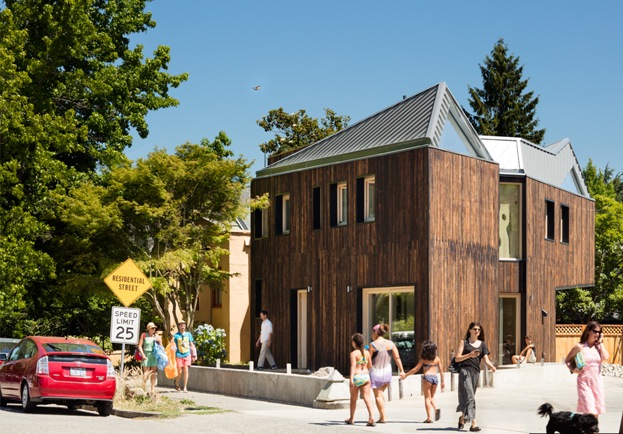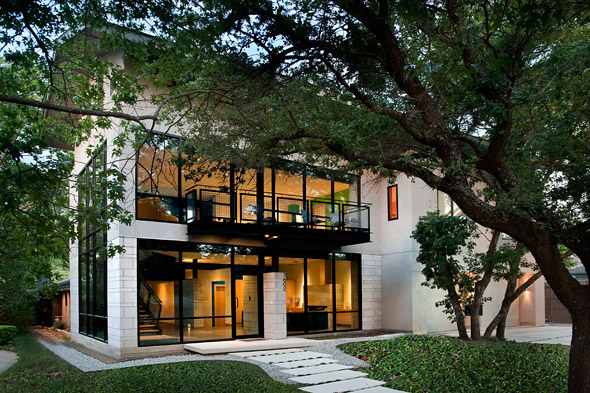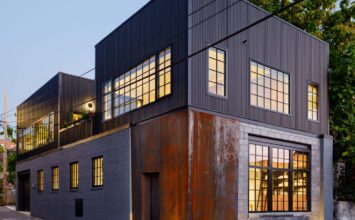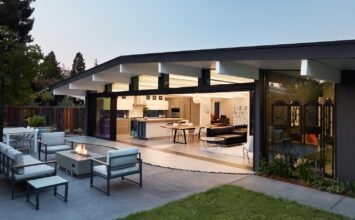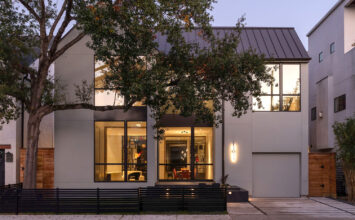
Modern Home Tours returns to Seattle on Saturday, April 30, opening the doors to some of the coolest digs in the Pacific Northwest. One home with which we can’t wait to get up close and personal is CLTHouse, a modest (yet stunning) 1,500 s.f. single-family house for a family of four, and the personal residence of architect Susan Jones of atelierjones.
That the homeowners are a writer/historian and an architect comes as no surprise once you consider the carefully layered thinking that went into its design. The home brilliantly pays aesthetic homage to the history of the region; in the architect’s own words, “the materiality of the house and the interior experiences recall ubiquitous small Pacific Northwest beach cabins, as well as the specifics of the site itself: once a beach itself, under 9’ of water in 1916, before the water levels were lowered by the building of the Ship Canal connecting lake to sea.”
The home is also the first in the state of Washington to be constructed using CLT – or cross-laminated timber, an engineered wood product prized for its structural properties and low environmental impact. Though widely used throughout Europe – in the UK, CLT has been used in the construction of wooden high-rises, and in Italy to create thousands of earthquake-proof houses – it is a technology only recently being explored in North America.
We caught up with Susan Jones to chat about CLTHouse, cross-laminated timber, PassivHaus detailing, and making the most of an odd-sized urban lot.
Q&A w/ Susan Jones, atelierjones
This home, as you describe it, is a “modest single family house for a family of four in urban Seattle.” It also happens to be your own personal home! How did you approach the design for your home, and was that process any different than how you would approach designing a home for a client?
The writer asked for a beach house by the sea. The writer asked for a library with light. The writer asked for a home for his children, who were larger than they had been when they were born. The writer asked for a home for his green egg. The writer asked for a home in a neighborhood with a walk score over 90. The architect asked for a home so her children (who had been living next to a freeway all their lives) could hear birds sing in the morning. The architect asked for a home for her husband’s books, which were many. The architect asked for a home that would bring light into her husband’s head in February. The architect asked for a home that would remind her of growing up in the fir and pine woods of the northwest. The architect asked for a home that no one else would build. The architect asked for materials that no one else knew much about building with, but were unusually beautiful. The architect asked for a home that would stretch our conception of tectonics and point a pathway to sequestering carbon. The architect asked for a home that took risks. The architect asked for a home that spoke volumes.

This project is named CLTHouse, pointing to its use of cross-laminated timber (CLT), which is an innovative new wood material. In fact, unless I’m mistaken, I believe this home was the first in Washington that uses CLT. What, exactly, is CLT, and what are its effects, both environmentally and aesthetically?
Emerging from central Europe in the 90’s, CLT – from local regional timber – is emerging as a highly efficient carbon sequestration strategy, encompassing interdisciplinary efforts between wood fabricators and foresters, academics and practicing architects, policy makers and non-profit leaders. An alternative to more carbon intensive materials of concrete and steel, mass timber is a viable and beautiful building material that if responsibly harvested becomes a highly sustainable strategy. The house required approximately 20 trees for construction, including 17 small-diameter Western White Pine trees required for the CLT-panel construction. In addition to harvesting these trees through a Canadian, FSC-plant certified company, Structurlam, the owner’s family planted an additional 20 trees to act as carbon sequestration for decades to come. The first CLT structure to be permitted in the City of Seattle, and one of the first in the US to utilize CLT both as structure and finish material, the house has been a research vehicle for the firm over the last four years, and has been widely shared with a broad-based, interdisciplinary CLT community locally and nationally, from code and policymakers to academicians, and the AEC community.

How did the specifics of the site inform your design vision for the house?
Leftover, odd-size lots are the provenance of a city that has grown organically over time; they layer our neighborhoods’ histories with the idiosyncratic dreams of prior owners, now lost to living memory. As owners sliced into their family lots, small fragments were sold, left to whither, often against transient alleys, vacant parking lots, abandoned buildings. In this case, the triangular lot was created by a fragment off of Madison Avenue, once, in the 1860’s a driveway for James McGilvra, Territorial Governor, under President Lincoln. Slicing over the city, across Seattle’s grid, Madison Avenue left many fragments of lots in its way. The triangular nature of the plan, forced three-dimensional experiences of space into the sections and volumes of the major rooms, as well as the shelter of the roof deck, surrounded by the prows of the house in two directions. An additional note: for centuries, the site had been underwater, and was not revealed as buildable land until the 1920’s after the Montlake Cut lowered the level of Lake Washington by 9’. Small notations of that underwater quality can be noted in the cross hatching of the exterior siding at approximately the lake level, or the subtle nautical themes that resonate in the interior detailing.

What materials were you drawn toward using for the space?
The house is shrouded in a blackened wood exterior, and a whitened cross-laminated-timber (CLT) interior left raw, lightly whitewashed. Washed in light, textures and smells of natural materials, and surrounded in green, the house requires a tiny, vertical central service core. Channeling utilities from basement to roof deck, the core is shrouded with glossy white and ice-blue finishes, of unnatural materials – gwb, plastic-laminate, stainless steel and quartz. Surrounding the core, dramatic vertically lit spaces of the interior open up through the kitchen core, through the staircase, up to the cedar roof deck with distant views of the lake. Clad in burnt, shou-sugi-ban treated Douglas Fir, the house is blackened on the exterior; the interior reveals the white, immersive, visceral natural experience.

The home was inspired by PassivHaus detailing — can you elaborate upon that, for those who aren’t as familiar with PassivHaus design and its sustainable advantages?
With its super insulated envelope, and tightly sealed construction, the house achieves a low ACH, or Air Changes per Hour, though well above Passive House standards. PassivHaus is a strict rating system that prioritizes a very well-built and highly sealed interior, with superb thermal protection. Early energy modeling and integrated design ensure that a PassivHaus requires very little energy to heat (or cool) and is unusually and beautifully comfortable, all year around. While the CLTHouse was not aiming for PassivHaus certification, it was a City of Seattle Priority Green project, with its Super-Insulated envelope – R-35 walls and R49 roof – includes Euroclime triple-glazed windows, a Heat-Recovery-Ventilation system, is sited and wired for future solar, and achieved a Built Green 5-Star rating.

What are a few details of the home that tour-goers should be sure to keep an eye out for?
Find the finger-jointed CLT! Spot the 3-ply layers of CLT that are exposed. And then find the 5-ply exposed layers. Bonus points for finding the dead blue-beetle killed pine timber in the walls!
Want to explore the CLTHouse in person? Grab your tickets to the Seattle Modern Home Tour here!
